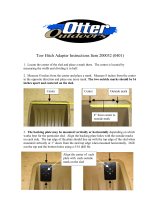
Removing an expansion card.................................................................................................................................... 35
Installing an expansion card...................................................................................................................................... 38
Removing the riser card............................................................................................................................................. 41
Installing the riser card...............................................................................................................................................43
M.2 riser ............................................................................................................................................................................. 44
Removing the M.2 riser..............................................................................................................................................44
Installing the M.2 riser................................................................................................................................................45
M.2 SSD module................................................................................................................................................................ 46
Removing the M.2 SSD module............................................................................................................................... 46
Installing the M.2 SSD module................................................................................................................................. 46
Linking board and PCIe cable......................................................................................................................................... 47
Removing the linking board and PCIe cable.......................................................................................................... 47
Installing the linking board and PCIe cable............................................................................................................ 48
Processor and heat sink.................................................................................................................................................. 49
Removing the heat sink............................................................................................................................................. 49
Removing the processor............................................................................................................................................50
Installing the processor.............................................................................................................................................. 52
Installing the heat sink................................................................................................................................................54
Liquid cooling heat sink with liquid leak sensor..........................................................................................................56
Removing the liquid cooling heat sink with liquid leak sensor cover.............................................................. 56
Removing the liquid cooling heat sink with liquid leak sensor.......................................................................... 57
Installing the liquid cooling heat sink with liquid leak sensor............................................................................ 58
Installing the liquid cooling heat sink cover...........................................................................................................59
OCP cards...........................................................................................................................................................................60
Removing the OCP filler............................................................................................................................................ 60
Installing an OCP card.................................................................................................................................................61
Removing an OCP card..............................................................................................................................................62
Installing the OCP card filler..................................................................................................................................... 63
System battery.................................................................................................................................................................. 64
Replacing system battery.......................................................................................................................................... 64
System board..................................................................................................................................................................... 66
Removing the system board..................................................................................................................................... 66
Installing the system board ...................................................................................................................................... 67
Trusted Platform Module................................................................................................................................................ 69
Upgrading the Trusted Platform Module...............................................................................................................69
Initializing TPM for users........................................................................................................................................... 70
Initializing the TPM 1.2 for users............................................................................................................................. 70
Initializing the TPM 2.0 for users............................................................................................................................. 71
Chapter 5: Jumpers and connectors............................................................................................ 72
System board connectors............................................................................................................................................... 72
System board jumper settings........................................................................................................................................73
Disabling a forgotten password..................................................................................................................................... 74
Chapter 6: System diagnostics.................................................................................................... 75
Dell Embedded System Diagnostics..............................................................................................................................75
Running the Embedded System Diagnostics from Boot Manager.................................................................. 75
Running the Embedded System Diagnostics from the Dell Lifecycle Controller......................................... 75
System diagnostic controls....................................................................................................................................... 76
4
Contents





















